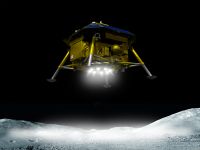SELENE-2 /ˈsɛlɪniː/, or the Selenological and Engineering Explorer 2, is a cancelled Japanese robotic mission to the Moon that would have included an orbiter, a lander and a rover.[3] It was intended as a successor to the 2007 SELENE (Kaguya) lunar orbiter.[4]
 | |
| Mission type | Orbiter lander rover |
|---|---|
| Operator | JAXA[1] |
| Spacecraft properties | |
| Launch mass | 5,000 kg[1] |
| Start of mission | |
| Launch date | Cancelled [2] |
| Rocket | H-IIA |
| Orbital parameters | |
| Reference system | Selenocentric |
Instead of SELENE-2, JAXA is working with the Indian Space Research Organisation (ISRO) to plan a joint mission called the Lunar Polar Exploration Mission (LUPEX).[5][6][7][8] The mission would send an uncrewed lunar lander and rover to explore the south pole region of the Moon no earlier than 2026.[9] JAXA is likely to provide the under-development H3 launch vehicle and the rover, while ISRO would be providing the lander.[10]
Overview
editThe lander would have targeted lava tubes and other permanently shadowed areas, which function as cold trap volatiles such as water. Water ice could be processed by future missions to produce spacecraft propellant (LOX/H2).[1]
- Orbiter
The orbiter would have a mass of 700 kg.[3]
- Lander
The lander would have a mass of 1,000 kg, and would be able to deliver up to 340 kg[1] of payload, including the rover. Its mission would last two weeks.[3]
- Rover
The rover would have a mass of 100 kg, and it would operate for two weeks.
Penetrators
editOne option JAXA was investigating in 2006, was to integrate a small data relay satellite and penetrators into the mission.[11]
See also
edit- Hiten (MUSES-A)
- Lunar-A
- SELENE (Kaguya)
- Smart Lander for Investigating Moon (SLIM)
References
edit- ^ a b c d Lunar Polar Exploration Mission. Tatsuaki Hashimoto, Takeshi Hoshino, Sachiko Wakabayashi, etal. Japan Aerospace Exploration Agency (JAXA). 6 January 2017.
- ^ Mission Concepts of Unprecedented Zipangu Underworld of the Moon Exploration (UZUME) Project. (PDF). Junichi HARUYAMA, Isao KAWANO, Takashi KUBOTA, etal. J-Stage. 3 July 2015. Accessed: 24 September 2018. Quote: "SELENE-2 was a mission with an intention to send a landing module to the Moon, and a lunar hole was a candidate for the landing site. However, the SELENE-2 mission was officially terminated in March 2015."
- ^ a b c Srinivas Laxman (2012-07-16). "Japan SELENE-2 Lunar Mission Planned For 2017". Asian Scientist. Retrieved 2012-08-07.
- ^ "Moon lander SELENE-2". JAXA Space Exploration Center. 24 December 2009. Archived from the original on 23 July 2010. Retrieved 2010-05-07.
- ^ "ISRO working on ambitious lunar missions LUPEX, Chandrayaan-4: Official". The Economic Times. 2023-11-17. ISSN 0013-0389. Retrieved 2023-12-15.
- ^ "India's next Moon shot will be bigger, in pact with Japan". The Times of India. 8 September 2019. Retrieved 10 March 2021.
For our next mission — Chandrayaan-3 — which will be accomplished in collaboration with JAXA (Japanese Space Agency), we will invite other countries too to participate with their payloads.
- ^ "Global Exploration Roadmap - Supplement August 2020 - Lunar Surface Exploration Scenario Update" (PDF). NASA. August 2020. Retrieved 10 March 2021. This article incorporates text from this source, which is in the public domain.
- ^ "ISRO's next Moon mission in collaboration with Japanese space agency gathers steam". The Economic Times. 2023-08-22. ISSN 0013-0389. Retrieved 2023-12-22.
- ^ 4th IPSC 2023 Inauguration. 2023-03-22. Event occurs at 1:18:09.
- ^ "Episode 82: JAXA and International Collaboration with Professor Fujimoto Masaki". Astro Talk UK. 4 January 2019. Retrieved 10 March 2021.
- ^ Tatsuaki Hashimoto (May 2006). "Robotic Lunar Exploration Scenario" (.PDF). JAXA. Retrieved 2010-05-07.
External links
edit- Manabu Kato, The Current Status of the Japanese Penetrator Mission Lunar-A, ISAS/JAXA, Information about the penetrator tests.